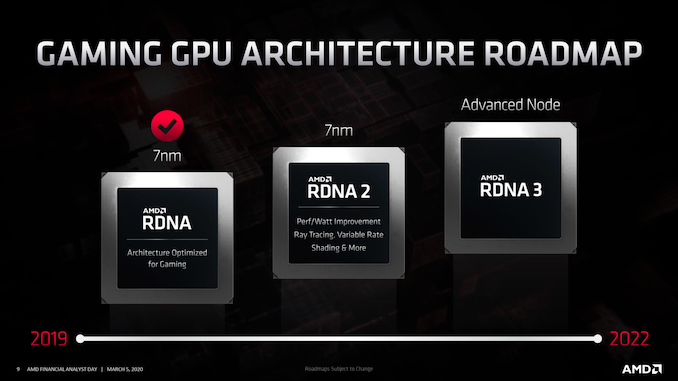AMD's 2020-2022 Client GPU Roadmap: RDNA 3 & Navi 3X On the Horizon With More Perf & Efficiency
by Ryan Smith on March 5, 2020 5:35 PM EST
As has become something of a tradition for AMD, this year’s Financial Analyst Day included a high level update to the company’s GPU roadmap. The last roadmap we saw from AMD, unveiled back at the Radeon RX 5700 XT launch last summer, went as far as RDNA 2. Now with RDNA 2 (Navi 2X) set to launch this year, AMD has extended the roadmap to include what’s next. And what’s next is RDNA 3.
The successor to RDNA 2, RDNA 3 will build off of what AMD will achieve in the coming quarters with their forthcoming GPU architecture. With RDNA 2 not off the ground yet, for obvious reasons AMD is saying very little about RDNA 3 at this time, especially with regards to features. But what we do know is that, like RDNA 2, AMD is targeting continual perf-per-watt increases, as power consumption remains the ultimate bottleneck to total GPU performance.
Helping AMD get there will be a new process node. For now the company is not disclosing which node it will be, using “Advanced Node” as a catch-all for what they decide to use. Coming off of TSMC’s 7nm process they will have several options to use, including TSMC’s 6nm and 5nm processes. And given TSMC’s roadmaps, it’s more or less inevitable that this will be the point where AMD begins using an EUV-based process for their GPUs, as AMD has indicated that this year’s RDNA 2 will not be using TSMC’s EUV-based 7nm+ process.
Overall AMD has a lot of work ahead of them. While RDNA (1) and Navi 1X helped to reinvigorate AMD last year, the company is still struggling to reestablish itself as a fully viable top-to-bottom competitor to market leader NVIDIA. AMD currently trails on hardware features, while their overall perf-per-watt is currently competitive, but due in part to AMD having an atypical advantage in manufacturing nodes. So continuing to quickly iterate their GPU architecture to improve both features and their overall perf-per-watt – including moving to newer manufacturing nodes – is exactly what the company needs to do in order to become the market leader they desire to be. On the whole it’s very Zen-like, and this is clearly intentional.
Meanwhile it’s interesting to see that AMD is going to keep the Navi architecture name leading into RDNA 3. With the architecture set to include numerous new features compared to RDNA (1) as well as a new process node, we’d normally see a naming break at some point along that line. As more details come out about AMD’s next two GPU architectures, we’ll find out more about just what AMD is changing and improving.










5 Comments
View All Comments
Novacius - Thursday, March 5, 2020 - link
"And given TSMC’s roadmaps, it’s more or less inevitable that this will be the point where AMD begins using an EUV-based process for their GPUs, as AMD has indicated that this year’s RDNA 2 will not be using TSMC’s EUV-based 7nm+ process."This is a little surprising, considering they mentioned 7nm+ for RDNA 2 on all prior roadmaps. The same applies to Zen 3, too.
Sharma_Ji - Thursday, March 5, 2020 - link
read other coverages, u will understand.dotjaz - Wednesday, August 5, 2020 - link
You do realise they also mentioned 14nm+ which doesn't exist and is ultimately 12LP right? How is it surprising when they previously mentioned 14nm+ and 7nm+ in the same PPT, 14nm+ turned out to be not 14nm+ and 7nm+ is not N7+?dotjaz - Wednesday, August 5, 2020 - link
https://www.nextplatform.com/2017/06/19/amd-winds-...There, you can see 14nm+ being mentioned in AMD official PPT and later turned out to be 12LP and 11LPP. Clearly indicating 14nm+ is merely refined 14nm which is exactly what 12LP and 11LPP are. So naturally 7nm+ is refined 7nm, which is N7P not N7+.
mode_13h - Sunday, March 8, 2020 - link
I'm betting they'll drop GCN support, in either RDNA 2 or 3. That's got to be chewing up some die space, and all software should be running in RDNA mode, by that point.